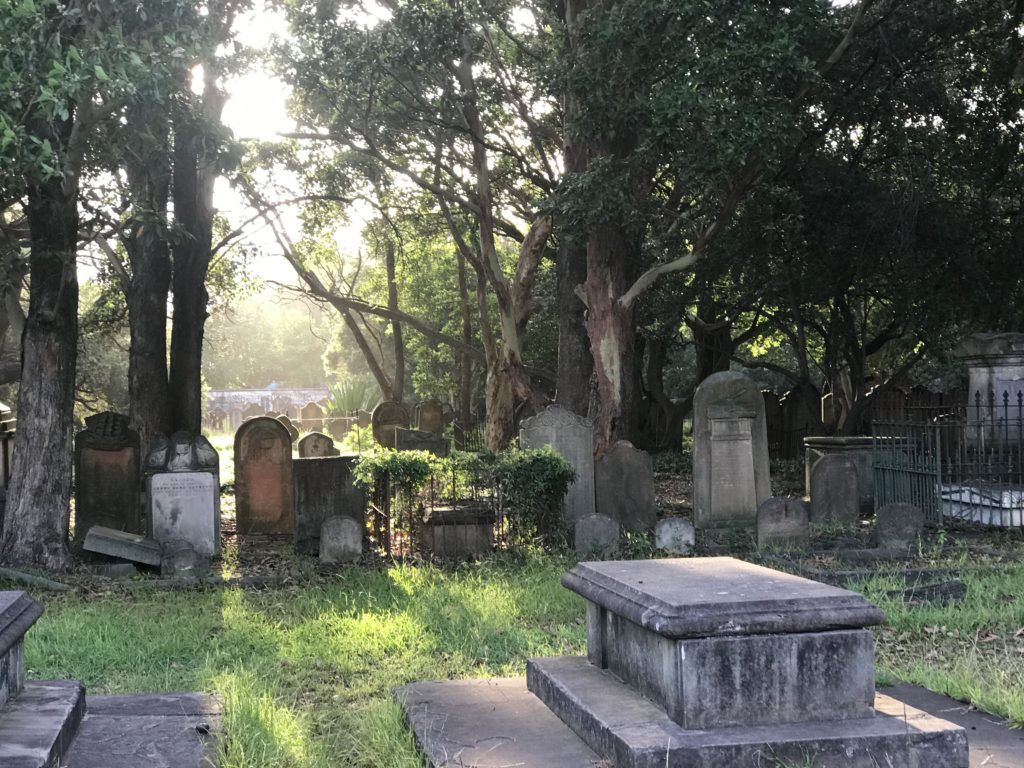Cemetery
Find out more about our historical space at Camperdown Cemetery
Cemetery tours are currently happening on the first Saturday of every second month at 11:30am (February, April, June, August, October & December) meeting under the fig tree. To find out more email tours@neac.com.au
In mid-2015 the Camperdown Cemetery Trust was awarded a medal of commendation from the council for their efforts in restoration and upkeep of the grounds.
In mid-2015 the Camperdown Cemetery Trust was awarded a medal of commendation from the council for their efforts in restoration and upkeep of the grounds.
Origins of the Graveyard
In 1848, a group of influential Church of England businessmen purchased 12½ acres of Camperdown land which had originally been granted to William Bligh upon his appointment as 4th governor of NSW. (Bligh named the land Camperdown after a victorious sea battle he had engaged in.)
These businessmen wasted no time and the following year established Camperdown Cemetery as a business proposition – to be the Church of England’s principal burial ground in Sydney.
They, laid out the ground in the popular plantation design which included a central circular path, divided the area into 56 sections of each 100 feet square, erected a 6 foot high paling fence to enclosed the area, built the sexton’s cottage and planted the fig tree at the entrance to the cemetery, and organised for the 1st grave to be put in place: the grave of Sir Maurice O’Connell, Bligh’s son-in-law, who had inherited and sold them land but had died a few months before. O’Connell’s grave was brought from the Old Devonshire Cemetery and placed in Camperdown Cemetery as its first interment.
And what a business proposition Camperdown Cemetery was, for in just 18 years the cemetery was considered well and truly full and was closed!
The cemetery buried a diverse range of people, from the eminent to forgotten convicts. Being a time of high infant mortality, it was not uncommon to find half a dozen children from one family buried here. There are also many graves connected to the sea – sailors, navy, Sydney Harbour drownings and shipwrecks.
Headstone DatabaseThese businessmen wasted no time and the following year established Camperdown Cemetery as a business proposition – to be the Church of England’s principal burial ground in Sydney.
They, laid out the ground in the popular plantation design which included a central circular path, divided the area into 56 sections of each 100 feet square, erected a 6 foot high paling fence to enclosed the area, built the sexton’s cottage and planted the fig tree at the entrance to the cemetery, and organised for the 1st grave to be put in place: the grave of Sir Maurice O’Connell, Bligh’s son-in-law, who had inherited and sold them land but had died a few months before. O’Connell’s grave was brought from the Old Devonshire Cemetery and placed in Camperdown Cemetery as its first interment.
And what a business proposition Camperdown Cemetery was, for in just 18 years the cemetery was considered well and truly full and was closed!
The cemetery buried a diverse range of people, from the eminent to forgotten convicts. Being a time of high infant mortality, it was not uncommon to find half a dozen children from one family buried here. There are also many graves connected to the sea – sailors, navy, Sydney Harbour drownings and shipwrecks.
Walled In
One hundred years on, the council felt they needed a public park in Newtown to cater for the growing population in Sydney. Closure of the cemetery was continually opposed by the church, however, lack of funds in the depression years causing the cemetery become an eyesore and then a murdered young girl’s body found in the cemetery grounds lead to a public outcry over the need for the overgrown cemetery to be cleared. The result was three-quarters of Camperdown Cemetery being resumed in 1948 for Camperdown Memorial Rest Park which opened in 1951.
All headstones from the resumed area were placed where ever they could fit within the reduced cemetery and the remaining placed against the sandstone wall that was built to separate the parkland from the cemetery. It was thought nailing the headstones to the wall would preserve the headstones but sadly as the nails have expanded with rust this has cracked almost all of the sandstone headstones on the wall.
This massive relocation of graves makes locating a headstone today a challenge. Also, sandstone being soft in nature has meant that there are only about 2000 headstones remaining, and many of those are not readable.
Tours of the Cemetery take place on the first Saturday of every second of the month at 11:30 am, meet under the fig tree.
(February, April, June, August, October and December). To inquire further email: tours@neac.com.au
All headstones from the resumed area were placed where ever they could fit within the reduced cemetery and the remaining placed against the sandstone wall that was built to separate the parkland from the cemetery. It was thought nailing the headstones to the wall would preserve the headstones but sadly as the nails have expanded with rust this has cracked almost all of the sandstone headstones on the wall.
This massive relocation of graves makes locating a headstone today a challenge. Also, sandstone being soft in nature has meant that there are only about 2000 headstones remaining, and many of those are not readable.
Tours of the Cemetery take place on the first Saturday of every second of the month at 11:30 am, meet under the fig tree.
(February, April, June, August, October and December). To inquire further email: tours@neac.com.au
Would you like to volunteer...

If you'd like to volunteer in the caring of the beautiful Camperdown Cemetery you can find out how here:
Find out more about cemetery volunteering